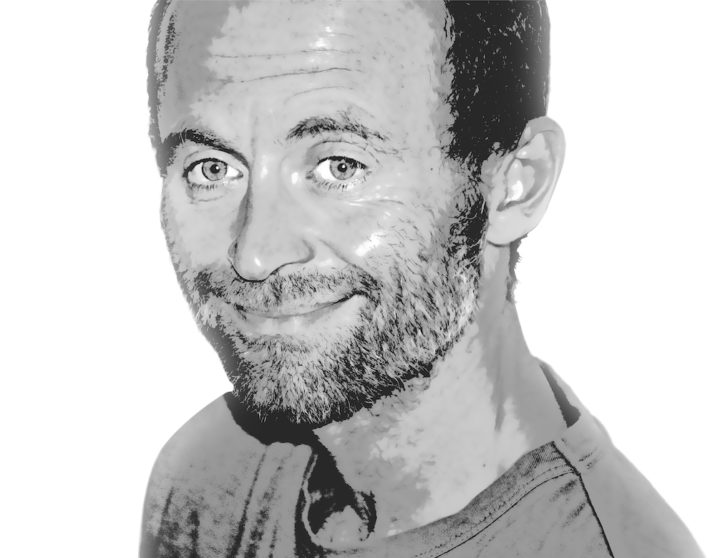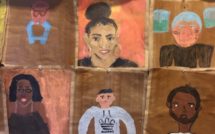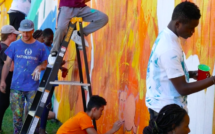

Poet Gold, Vassar President Elizabeth Bradley, Poughkeepsie Mayor Robert Rolison, Vassar Professor Maria Höhn, and New Americans Head Counselor Matthew Brill-Carlat pose in front of a mural featuring a character from Jérôme Ruillier’s graphic novel, The Strange.
This is part of our special feature on forced migration, Narration on the Move.
Factors like climate change, political violence, and economic disparity are compelling more people to migrate, and writers are learning to represent the increasingly common experience of displacement. The story of any migration, of course, is determined by the person who makes the journey as well as those who welcome her, or refuse to do so. As police officers, landlords, neighbors, activists, and bystanders shape their society’s response to forced migration for better or worse, storytellers have the opportunity to promote a compassionate and nuanced understanding of the challenges associated with starting anew.
Jérôme Ruillier, author of The Strange, embraces this task in his most recent graphic novel. Ruillier was born in Madagascar and currently resides in France. He is a prolific children’s book illustrator and the author of several graphic novels, including Le Coeur-enclume (2009) and Les Mohamed (2011). His most recent graphic novel, The Strange (2018), focuses upon migration. The book condenses actual interviews and political events into the story of a fictional undocumented migrant, also named “the Strange,” who arrives in a European or North American city. With a pared down writing style and simplified, almost child-like, drawings, The Strange nevertheless manages to convey a complex tale about contemporary migration.
The book’s themes, as well as its inimitable style, earned the admiration of the eighteen high school students who spent two weeks at Vassar College’s New Americans Summer Program. Supported by the Mellon-funded Consortium on Forced Migration, Displacement, and Education, students took academic classes and participated in art projects. In one of these classes, Brittany Murray’s humanities seminar, students read and discussed The Strange. Many students found that the story resonated with their own recent experiences of migration; the book tackled issues that the students were passionate about like police-community relations, fair housing, xenophobia, and pro-migrant activism. So effective, in fact, was the graphic novel at distilling these concerns, that when students painted a mural about migration, pictured above, Jérôme Ruillier’s character made a surprise appearance. Below, three students from the class, along with Prof. Murray, interviewed the author about the process of writing the book and the future of forced migration.
—Brittany Murray for EuropeNow
EuropeNow Why did you decide to write about migration? Fatima from Albany, NY asks, “How did you come up with the idea for this story? Did somebody inspire you?”
Jérôme Ruillier I was walking down the streets in my little town of 20,000 people. I ran into a protest where people were defending the rights of a migrant; this person had been placed in an immigration detention center and was about to be sent back to his or her country of origin. In the crowd, I saw a friend, the sponsor for the person in question, and a member of RESF (Réseau éducation sans frontières), a network of organizations devoted to protecting undocumented families from separation.
A few days later, I recorded an interview with this friend, and then I interviewed several migrants, activists, and people with links to immigration, either close or distant connections. I also interviewed a police officer. A few months later, I started the work of transcription and the actual writing of the graphic novel.
For about twenty-five years, I have been the author of children’s books and graphic novels, and during that time I have always focused on themes like difference and alterity. The question of difference has been part of our lives for twenty years, the age of our oldest daughter, who has Down syndrome or trisomy 21.
Every day, we have to stand up to people’s suspicious looks, to stigmatisation, rejection, to the problem of integration, and such. All of these issues are, in their own way, very close to the issues that go with immigration. I had already connected disability with immigration in an earlier graphic novel, Les Mohamed.
EuropeNow Can you describe the process of preparing for the book? Sthephany from Queens, NY asked, “How long does the process take from beginning to end? How many sketches does it take to get the story the way you want it?“
Jérôme Ruillier Once you find the subject, and after the time it takes to gather testimony and transcribe the interviews, then it is time to think about whether this comic is going to be journalistic, nonfiction, or fiction. Every option has its advantages and disadvantages. For The Strange, I chose fiction. By dramatizing the story, fiction offers, I think, more “breathing room” for the reader.
Then comes the work of the actual writing. You have to find a story: what do I want to say? You have to select a writing style: neutral, bare, or on the opposite end of the spectrum, very stylized? You must decide which narrative techniques to employ: how is the story told and by whom? According to which principle? Finally, you design the graphics: will you use anthropomorphic characters? It is all about finding the “right” style to get as close as possible to what I want to say.
To get to the final version, it will take me three or four different drafts. Each draft is about a hundred pages long, or about a year of work. Of course, I am simultaneously working on other graphic novel projects or children’s books.
EuropeNow The title of the book is also the name of the protagonist. Fatoumata from the Bronx, NY asked “Why did you choose the name, The Strange?”
Jérôme Ruillier I do not know exactly why anymore! When I am working on the book, several titles emerge, certain one fade away, and other ones appear.
When our oldest daughter was born, the one with trisomy 21, the pediatrician told us that she was born “different.” Among the synonyms for different, there is “odd,” “foreign,” “strange,” “stranger.” (And also: singular, exceptional, new!) By making a graphic novel about migrants, it is clear to me that I am writing about the fear of the other in a more general sense (if not universal, or “collective,” to borrow a term from the novelist Annie Ernaux). So, that is a way for me to link issues specific to my daughter to those that we face when we talk about the more general question of immigration.
EuropeNow The book incorporates quite a few actual political sources. There are quotes from past French presidents, for instance. Can you explain why you chose to include those pieces?
Jérôme Ruillier It was important to reground the narrative in a current, political context in order to contextualize the story. I also had to put sound to the images. I took three years to do the graphic novel. When I started, Nicolas Sarkozy was president of France and then as I was finishing the book, François Hollande was elected. Despite the changing of the guard politically, the discourse was basically the same in every way and nothing had changed! The book ends with a quote from Marine Le Pen, president of the far right, who might be a sign of things to come.
EuropeNow Some students wondered if your perspective changed as you researched and wrote the book. Fatoumata asked, “How did this book influence your life?”
Jérôme Ruillier The book is important for me, but it has not changed my life in any specific way. My ideas have not changed; in fact, the opposite has happened. I still think that we are tackling the problem the wrong way! The question for me is not to know if we can welcome migrants, but how to welcome them.
EuropeNow We will not give away the ending for readers who want to check out The Strange for themselves. We will only say that many students felt like the book ended on a note of ambiguity. Sthephany and Fatoumata both want to know, “Why did you choose to end the book with uncertainty?”
Jérôme Ruillier I do not think of the ending as ambiguous, in fact, I think it is terribly clear and realistic! Basically, an uncertain future for the main characters seems like the right ending to me. But I will not give away any more.
EuropeNow As a class, we ended with a discussion about what lay ahead for the book’s main character. How do you imagine the future for people on the move? Are you optimistic?
Jérôme Ruillier I think that migration will only increase, whether because of politics or climate change. To think, still today, that we can fix the problem with walls or with cheap nationalism, that strikes me as naïve and dangerous! I think it is necessary to think of hospitality as a real obligation, and in light of what is happening in the world, I am not optimistic.
In spite of it all, I am working on a new graphic novel project on the topic. Currently, the title is The Migratories. Before that, it was Those who stay begin again and who knows about tomorrow! I am still using testimony, and this time I am planning more realistic drawings and a resolutely optimistic ending. Yes, I want to say, integration is great… and it works!
Thank you very much for your attention, and to those of you who read my work. I wish everyone the best, wherever your path leads you.
Jérôme Ruillier is a prolific children’s book illustrator and the author of several graphic novels, including Le Coeur-enclume (2009) and Les Mohamed (2011). His most recent graphic novel, The Strange (2018), focuses on migration. Ruillier was born in Madagascar and currently resides in France.
Brittany Murray is a scholar of French and Francophone Studies who teaches forced migration at Vassar College. Her first book project was Taking French Feminism to the Streets: Fadela Amara and the Rise of Ni Putes Ni Soumises, and she is working on a book about the 1970s, a decade of economic upheaval, changing gender roles, and new migration policy in France. She is also the Program Coordinator for the Consortium on Forced Migration. Displacement, and Education.
Published October 29, 2019.




